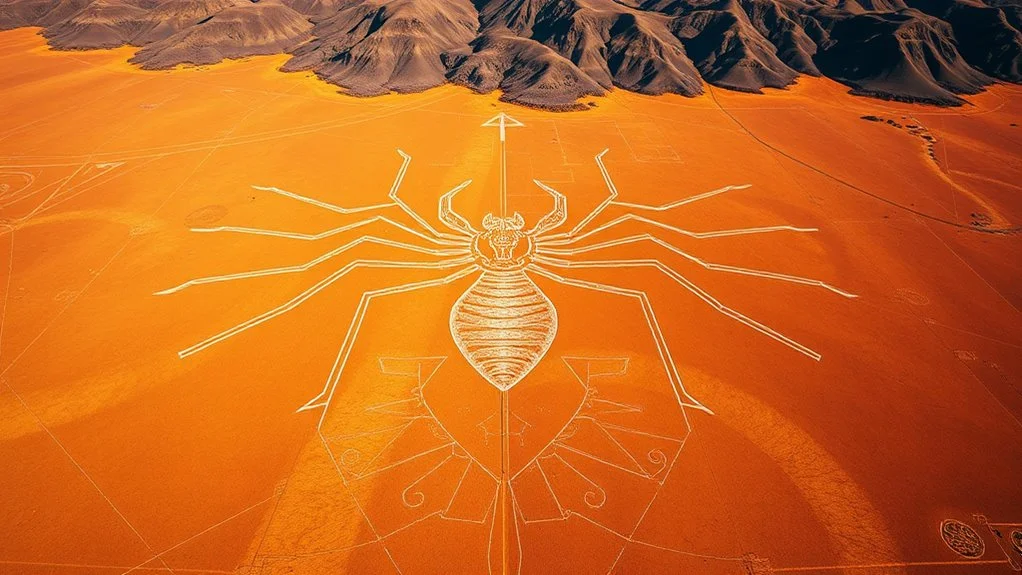Lines of Nazca: A Mystery of Peru’s Ancient Civilizations
The Nazca Lines are large geoglyphs in Peru created by the Nazca civilization. These designs cover vast areas and show the skill of ancient peoples. They may represent not just art but also knowledge about astronomy and farming. Questions about how and why they were made remain. Researchers continue to explore how these ancient people interacted with their land and the sky. What more could we discover about these fascinating symbols?
Key Takeaways
The Nazca Lines are large geoglyphs made by the Nazca culture between 500 BCE and 500 CE. These lines show the Nazca people's connection to their environment and beliefs. The geoglyphs include various symbols, such as animals and geometric shapes, each representing specific meanings related to nature and society.
Some theories suggest that the lines had ritual purposes. They may have marked paths for offerings or aligned with astronomical events to help with agricultural calendars. The Nazca people used surveying techniques and simple tools to create these intricate designs, showcasing their teamwork.
Research continues to reveal new lines and further our understanding of the Nazca civilization's significance. The combination of technology and fieldwork allows us to learn more about this ancient culture.
The Origins of the Nazca Lines
The Nazca Lines originated from the Nazca culture in southern Peru between 500 BCE and 500 CE. This civilization created large geoglyphs that reflect their connection to their environment and beliefs.
Scholars believe the lines acted as markers for celestial events, such as solstices. Some designs align with these events, showing the importance of ancient astronomy in their creation.
The geoglyphs may also represent rituals or paths that fostered community among the Nazca people. Understanding these origins helps us appreciate the cultural significance of the lines and the civilization that created them.
The Types of Geoglyphs
The Nazca Lines feature various geoglyphs that highlight the Nazca culture. The types of geoglyphs include animals, plants, and geometric shapes.
For example, the monkey and hummingbird designs show the civilization's bond with nature. Each symbol has specific meanings; the spider may symbolize fertility, while the condor often represents power.
These images served significant purposes, possibly related to religion or society. Studying these geoglyphs helps us understand the values and beliefs of the Nazca people.
As you learn about these symbols, consider how they still inspire curiosity and wonder today.
Theories Behind Their Purpose
Researchers study the Nazca Lines to understand their purpose. Some scholars believe these large geoglyphs had ritual significance. They may have served as paths for religious ceremonies or offerings to gods. This view suggests the lines helped the Nazca people connect with the cosmos during their spiritual practices.
Other researchers think the lines align with astronomical events. This reflects the Nazca civilization's knowledge of celestial movements. These alignments might've been important for agricultural calendars or navigation. This understanding could have helped the community survive.
Exploring these theories shows how the Nazca Lines represent the blend of culture, spirituality, and science. They reveal a rich history of ancient knowledge that continues to intrigue us today.
Techniques Used in Creation
Understanding how the Nazca Lines were created requires a look at the methods and tools used by the Nazca people. They used careful planning and skilled execution to make these designs.
Here are some key points to consider:
- The Nazca people used surveying techniques to align the patterns accurately.
- They'd simple tools to scrape the surface of the ground.
- They used natural markers to help guide their designs.
- Community collaboration ensured that the patterns were precise.
These techniques show how the Nazca civilization worked together to create their famous lines in the desert.
The Lines of Nazca in Modern Culture
The Nazca Lines have become a captivating part of modern culture. People worldwide are curious about these ancient geoglyphs. Today, their influence appears in art, fashion, and architecture. Many modern interpretations exist, including graphic designs and interactive exhibits. These forms aim to connect you with this cultural heritage.
Documentaries and social media increase interest in the Nazca Lines. They invite you to explore different theories about their purpose. Engaging with these interpretations allows you to join a global community eager to understand the mysteries of the Nazca Lines.
This shared interest fosters a sense of belonging and encourages deeper exploration of human history.
Ongoing Research and Discoveries
Recent advancements in technology improve our understanding of the Nazca Lines. Researchers use new tools to discover more about these ancient geoglyphs.
- Enhanced satellite imagery shows lines that weren't seen before.
- Ground-penetrating radar finds hidden archaeological sites.
- Drones create detailed aerial surveys, which improve mapping accuracy.
- AI analysis reveals patterns and connections in the designs.
These technologies change how we view the Nazca civilization. They suggest a close relationship between the lines and the people who made them.
As you follow this research, you join a journey to uncover the mysteries of the past. This work helps us appreciate the creativity of ancient cultures and their links to our modern world.
Frequently Asked Questions
How Were the Nazca Lines Discovered by Modern Archaeologists?
Modern archaeologists discovered the Nazca Lines using aerial surveys and satellite imagery. These advanced methods helped reveal large geoglyphs that were not visible from the ground. This discovery captured global interest and fascination. The Nazca Lines, with their unique designs, continue to intrigue researchers and visitors alike.
Are There Any Similar Geoglyphs in Other Parts of the World?
Yes, there are geoglyphs in other parts of the world. The Uffington White Horse in England and the Atacama Giant in Chile are notable examples. These large figures carved into the land show similarities and spark interest in how ancient cultures expressed themselves artistically.
What Do Local Indigenous Communities Think About the Nazca Lines Today?
Local indigenous communities regard the Nazca lines as culturally important. They believe these lines tell stories of their ancestors and reflect their traditions. The communities focus on preserving the lines and showing respect for their heritage. This connection to the geoglyphs helps them maintain their identity and share their history with future generations.
Can Visitors See the Nazca Lines in Person?
Yes, you can visit the Nazca Lines through organized tours. These tours offer aerial views, so you can see the size and design of these ancient geoglyphs. This experience helps you connect with history in a meaningful way.
What Challenges Do Researchers Face Studying the Nazca Lines?
Studying the Nazca lines poses challenges in interpretation due to their size and detail. Researchers face issues in preserving the lines, as environmental factors and human activities threaten their condition. These challenges make it harder to protect the lines for future research and understanding.

Hi, I’m Ethan—a spiritual wordsmith at SpiritualDivineInsight.com. My passion lies in exploring the mysteries of spirituality and sharing transformative insights. Through my articles, I invite you on a journey of self-discovery and mindfulness. Join me as we navigate the path to enlightenment together.







